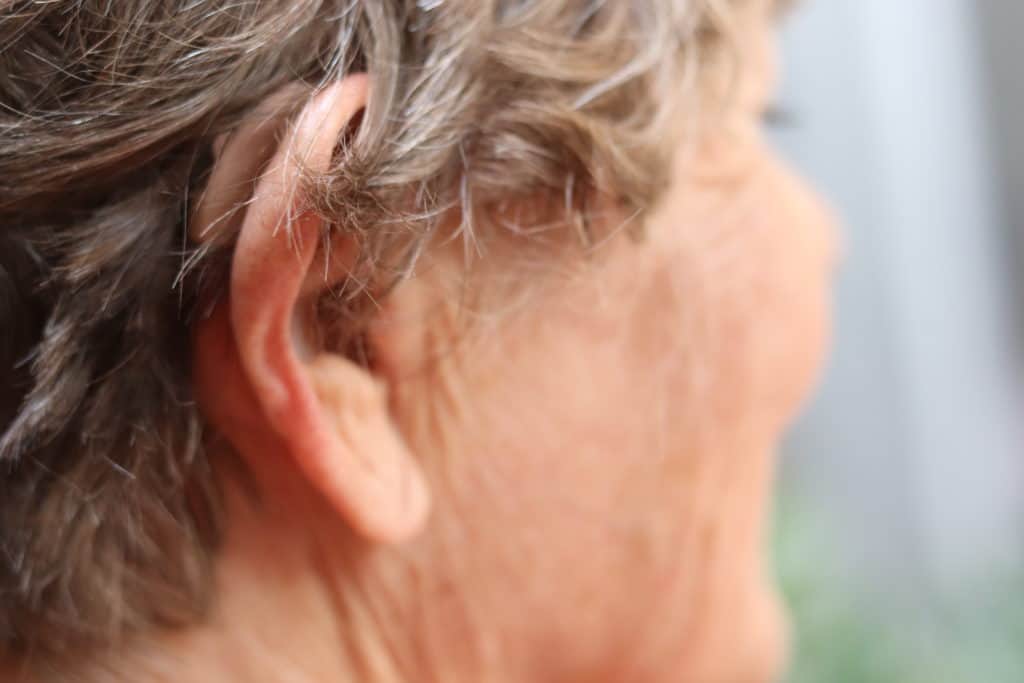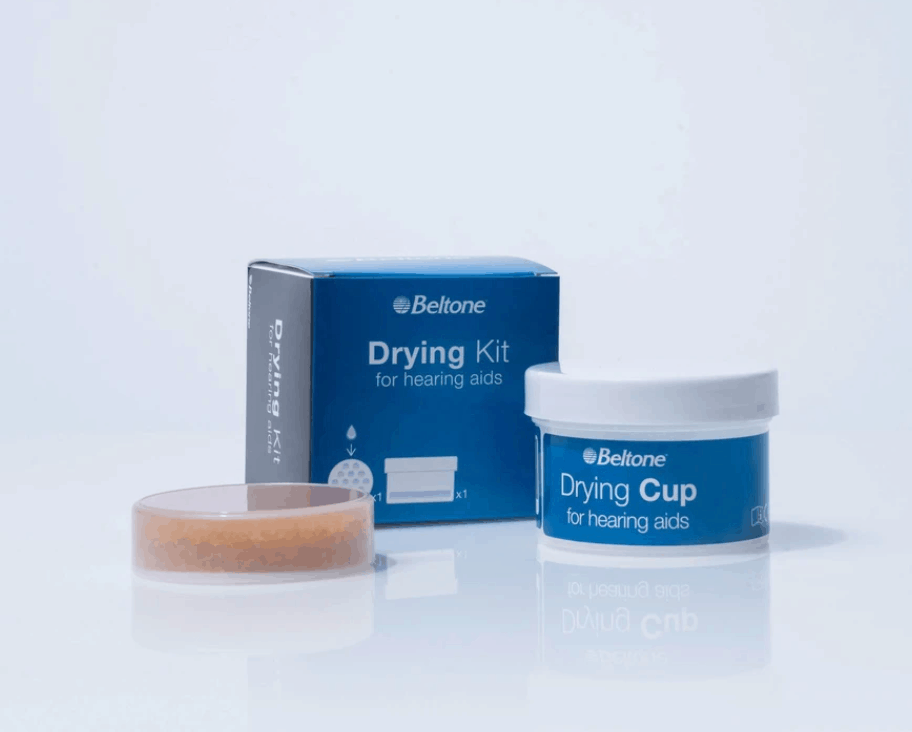How to Clean Hearing Aids
Properly maintaining your hearing aids will keep them working longer and more effectively.
SeniorLiving.org is supported by commissions from providers listed on our site. Read our Editorial Guidelines
Caring for Your Hearing Aids
According to the National Institute on Aging (NIA), around one-third of people between the ages of 65 and 74 experience hearing loss.1 If you’re wearing a hearing aid, you’re certainly not alone! Learning the proper way to clean hearing aids safely is essential. It’s not only an investment in your hearing health but extends the life of your hearing aid. Learn how often you should clean hearing aids, the tools needed, and what you should never use when taking care of your devices.

Our editor's grandma wearing her freshly cleaned BTE devices. You can barely see them!
Our Top Picks For Quality Hearing Aids
Some hearing aids are easier to clean than others. That said, most high-quality hearing aids are designed to be low maintenance for seniors. This means you can take them out for a quick cleaning without special instructions or equipment. If you’re currently on the lookout for a pair of hearing aids or you’re thinking about replacing your current hearing aids, be sure to check out the top-rated providers that we have reviewed.
Check Your Hearing Aid Manual for Tips and Tools
No two hearing aid brands or products are alike. Carefully read through your manual to learn any important cleaning tips that are specific to your device. Depending on the package and accessories you purchase, your hearing aids may come with a toolkit to help with cleaning your hearing aids.

Hearing Aid Cleaning Kit from Beltone
Need Help Finding the Right Hearing Aid?
Answer a few easy questions to find the hearing aid that’s right for you.
What Tools Can You Use to Clean Hearing Aids?
Having the right tools in your hearing aid maintenance kit is key. Make sure to clean your hearing aids on a flat surface to avoid dropping and damaging them.
Wax removal brush: Hearing aids can block earwax from naturally exiting the ear. This causes earwax buildup, a common problem for people with hearing aids. You can easily remove debris with a wax removal brush to avoid buildup. This soft-bristled brush gently cleans wax, dirt, or skin particles from your hearing aid surface. Don’t apply too much pressure when using the wax brush, as it will push the earwax buildup further into your hearing aid.
Did You Know: The accumulation of wax on your hearing aids can disrupt the sound by creating whistling or squeaking feedback.2
Dry cloth: While it may be tempting to use a damp cloth to clean hearing aids, any wetness can cause damage. Use a dry cloth to wipe down the hearing aid’s exterior. It’s important to use a non-abrasive cloth to avoid scratches. Microfiber cloths, like the ones used for cleaning glasses, are an excellent choice for cleaning your hearing aids.
Wax pick: A wax pick or loop removes wax from small openings on your hearing aid. Avoid inserting the pick into the microphone portion.
Tube cleaner: Wax and other debris can become trapped in the tube portion of your hearing aid. Tube cleaners are long, thin brushes that allow you to clean this hard-to-reach area carefully.
Bulb blower: Moisture can accumulate in the tubing of your hearing aid. A bulb blower forces air into the hearing aid tube to clear it out.
How Often Do You Clean Hearing Aids?
Just like a car, your hearing aids need regular maintenance. Properly caring for your hearing aids ensures they remain in tip-top condition.
Hearing Aid Cleaning Schedule
Daily
- Using your soft cloth, wipe down the exterior of the hearing aid.
- With your wax removal brush, brush over the microphone.
- If you see moisture within the hearing aid tube, use the bulb blower.
- At bedtime, open the hearing aid battery compartment to allow any moisture from perspiration to dry out.
Weekly
- Use your wax pick to clear away any stubborn wax or debris.
- Using your tube cleaner, dislodge any clogged wax from the sound tube.
How to Clean Your Hearing Aids
Set yourself up for success with the right tools and maintenance schedule to clean your hearing aids properly. Be sure to wash your hands thoroughly before you begin cleaning.
How to Clean RIC (Receiver-in-Canal) Hearing Aids
- Wipe down the entire hearing aid with a dry, soft cloth.
- Clean the behind-the-ear microphone ports with your cleaning brush.
- If your hearing aids have a removable “wax guard” look at it, and replace it if you see yellow or brown wax inside the white circle. Some common names for wax guards are CeruStop, Hear Clear, and ProWax. They are usually inside small cardboard packs about the size of a matchbook and should be in your hearing aid starter kit.
How to Clean BTE (Behind-the-Ear) Hearing Aids
If you have a behind-the-ear (BTE) hearing aid that hooks over the top of your ear and rests behind the ear (such as a device from MDHearingAid), it’s essential to pay close attention to cleaning both the external and internal parts of your hearing aid.
- Wipe down the entire hearing aid with a dry, soft cloth.
- Clean the behind-the-ear microphone ports with your cleaning brush.
- Use the wax pick to remove any impacted wax or residue on the tip that goes into your ear canal.
- If you have a custom lucite earmold, you may have a wax guard at the tip. This should be changed whenever you hear a drop in sound volume or quality.
- Use your tube cleaner to dislodge trapped debris. This looks like a piece of fishing line about 4 inches long.
- Use the bulb blower to remove moisture trapped in your hearing aid tube. These are not always included in your startup kit, so if you need one, ask your hearing care professional.
How to Clean ITE (In-the-Ear) Hearing Aids
The electronics that keep your in-the-ear hearing aid (such as an ITE device from Eargo or Beltone) working properly are all located in the earpiece (also known as the shell).3 ITE hearing aids are prone to wax, dirt, and other buildup, as they fully reside inside your ear.
- Wipe down the entire hearing aid with a dry, soft cloth.
- Use your cleaning brush to brush over the openings of the microphone and battery door to remove debris buildup.
- If your hearing aid comes with a wax trap, replace the wax trap as needed. The wax trap is located on the tip that goes into your ear.
- Clean the vent hole with the tube cleaner.
Things to Avoid When Cleaning Your Hearing Aids
If you’ve compared some of the best hearing aids on the market, you know they can be a costly expense. Prolong the life of your hearing aids by avoiding these actions that can damage or break your device. When cleaning your hearing aids, never:
- Clean hearing aids with an alcohol or chemical solution. These can damage the circuitry and short out your hearing aid.
- Get your hearing aids wet. Water is like kryptonite to hearing aids, as it can damage electronic components.
- If you notice your hearing aid needs repairing as you clean, don’t attempt to do it yourself. Contact your audiologist.
A Few Words About Troubleshooting
Despite regular cleaning as described above, sometimes your hearing aids stop working or become weak or distorted. Before initiating a repair that leaves you without your hearing aids for up to two weeks, take a moment and check the “three Ps” below:
1. Plumbing
Make sure all input and output sound paths are clear.
Input Path
As noted above, microphones should be brushed daily. The hearing aid brush included in your delivery kit is tiny, so if you have a hard time using it, it’s fine to use a soft-bristled toothbrush, but be sure to leave the toothpaste in the medicine cabinet!
Output Path
Amplified sound needs unimpeded access to your eardrum for you to hear. If the tube (BTE) or wax guard (RIC or ITE) is clogged, that sound will be reduced or stopped completely. About 90 percent of “dead” hearing aids in my clinic just need a new wax guard or to have the tube cleared of debris.
2. Power
If the plumbing is clear and the hearing aid still doesn’t work, check the power.
Hearing Aids with Zinc-Air Batteries
If one hearing aid works and the other doesn’t swap the batteries. If the issue is the power (battery), the “dead” hearing aid should work, and the other should stop. If this doesn’t get the dead device working again, it’s not the battery.
Rechargeable Hearing Aids
When you put hearing aids in a charger, a few things should happen; the power indicator on the charger and the progress indicators for each hearing aid should light up. If you see a steady amber or green light on one aid and a flashing red one on the other, this is usually an indication that something is wrong with either that hearing aid or that charging port.
If you determine the issue is the hearing aid, try cleaning any visible brass dots on the hearing aid (charging contacts). If there are no external contacts (some hearing aids use inductive charging and have no physical contacts), then you’ll need to send it to the manufacturer.
If the issue turns out to be the charger, and you see physical contacts in the charging wells, you can put a small amount of rubbing alcohol on a cotton swab and rub the contacts vigorously.
3. Performance
If your hearing aid passes both the plumbing and power tests, you’ll need to send them to the manufacturer for service. If you bought them online from a company like Jabra Enhance or Eargo, contact them for advice on sending them in. Be sure to detail the troubleshooting you’ve already done. If you bought them from a local provider, email or call them and arrange to either drop them off or mail them in.
Take Our Free Online Hearing Test
Wondering if you have hearing loss?
Grab your headphones and get an evaluation in minutes.
National Institute on Aging. (2021). Hearing Loss: A Common Problem for Older Adults
AARP. (2020). The Ins and Outs of Safe Earwax Removal.
Phonak. (2021). Cleaning and care.




